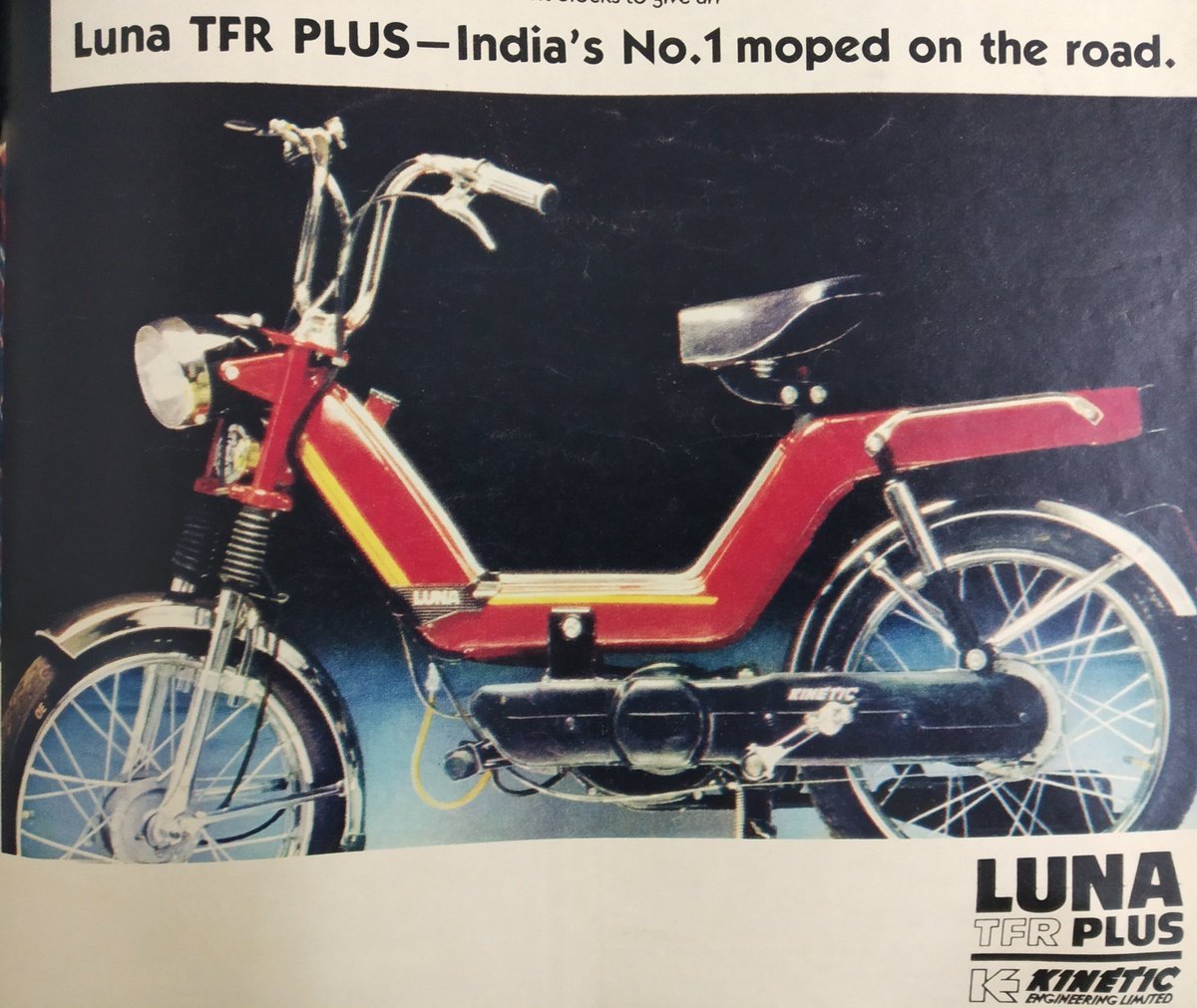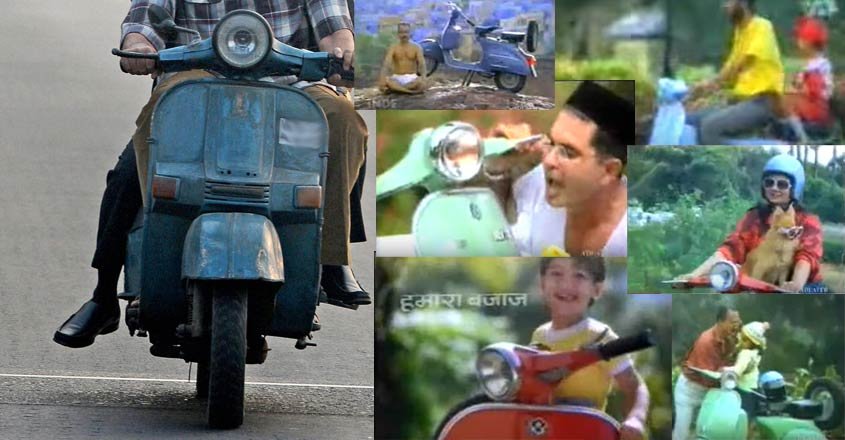
Till the 70s, the common Indian’s mode of transport was bicycle. Four wheelers were exclusive to the rich and even motorbikes were not affordable for the middle class. In 1972, a Pune based company launched a moped, Luna. Luna was a light, lean upgraded version of a cycle and not heavy on the pocket of a common man.

Luna launched a highly successful ad campaign with a middle class man, burdened with work, reaching office and home late every day, wasting a lot of time and energy in commute. He buys a Luna that takes him to office on time and he gets to spend more time with his family. A young doctor Radha who is late to reach the hospital every day and her work is affected. She buys a Luna and now she paces along the roads, ahead of even four wheelers and zips fast to achieve her dreams.
The tagline of Luna – ‘Kharcha kam mazbooti zyada, Luna karti pakka vada, chal meri Luna!’ This was an iconic ad on Indian television. Luna became a two wheeler of choice for everyone. It provided mobility to a large segment of population that upgraded to the easy Luna ride. A large number of women were Luna riders, a sort of social change in India. The flat design made it easy to ride a Luna in any attire, be it saree, salwar or trousers. Many of my teachers in school used to ride Luna.
With time, Luna gave way to sturdier mopeds with higher power. TVS entered the lucrative segment and Luna gradually lost its market. Mopeds were still bought and used purely for convenience and ease of going from point A to B, without any other major attributes related to the brand. I remember milkmen coming with large cans of milk to deliver at every doorstep on these mopeds. Traders used mopeds to carry their stock every day across the city. The roads, with large potholes and bumpy rides did not dent these sturdy birds, they were in fact preferred for the ability to manoeuvre every bend.
Around the same time, in 1972, Bajaj launched the Chetak scooter. Chetak became the largest selling scooter in India with higher power, sturdy body and an affordable price bracket. Unlike the brand positioning of two wheelers today, with a focus on accentuating one’s personality, power, independence, or an effervescent, outgoing persona, Bajaj was positioned a family two wheeler. One could easily spot a family of four or five riding comfortably on a Bajaj Chetak, across town. The scooter had a manly image and was driven largely by men, unlike the mopeds.

For Indian businesses, this was the dreaded licence raj era. There was an assigned quota for number of units that could be manufactured by a business. The demand for Chetak was very high and as a result, there was a waiting period of not months, but years, to get the delivery of the scooter! Ridiculous as it may sound, this was a reality.
Noted author Gurcharan Das in his book ‘India Unbound’ wrote about the licence raj, “Finally, a frustrated Rahul Bajaj went the non-cooperative way and started increasing his quota. As expected, the govt threatened him with imprisonment and filed MRTP (Monopolies and Restrictive Trade Practice) case against him. During the trial, the judge asked Bajaj if he is ready to go to jail for his ‘mistake’ for which, Bajaj replied “My grandfather went to jail for my country’s freedom. I stand ready to do the same for producing on behalf of my motherland”. Nothing happened after that. The case was dropped.”
For those born in the new millennium, the Gen X/Y/Z, the conspicuous consumers and opinion makers, who dictate the fortune of several brands by a tap of their fingertip on a rectangular screen, this kind of situation is simply unimaginable.
However, Bajaj remained a chartbuster on Indian roads, due to its monopoly and a favourable price value equation it offered. By the mid-80s motorcycles hit the roads and consumers were slowly graduating to the faster and slicker bikes that appealed to a more stylish, individualistic persona of the rider. With a stiff competition from stylish bikes and International brands, in scooter as well as bike market, Bajaj came out with ‘Hamara Bajaj’ Ad Campaign in 1989.
The jingle turned out to be a massive hit. Apart from celebrating the ordinary life of an ordinary Indian, it invoked a pride in our desi-ness, and heralding of a new India, rising from the middle class dreams and our glorious and unique identity.
‘Buland Bharat Ki Buland Tasveer, Hamara Bajaj’ was indeed an anthem for Brand India and Indianness. Atmanirbhar Bharat, catered to by a fully Atmanirbhar Brand ‘Bajaj Scooter’. The ad showed a just- married young couple exuberantly leaving for their honeymoon on a Bajaj scooter. A young guy in dark glasses setting his hair in the rear view mirror, a middle-aged man out shopping for fish with scooter parked next to him, a lady in helmet stumbling but learning and enjoying how to ride a scooter. There was the perfect tadka of religious harmony too. Children flying kites, dad picking his daughter from school, cute kids perched atop the scooter pretending to ride. Typical scenes from Indian streets and markets played alongside a catchy jingle. The ad clip went on to become one of the landmark campaigns in Indian advertising industry.
Bajaj scooter faded from the market gradually, taken over by motorbikes and scooters that gave mechanically superior performance, were easy to ride, lighter and better designed.

I never rode the heavy Bajaj scooter but quickly bought Hero Puch, a cross between a motorbike and moped. Why? Because Amir Khan, the young sensation, was the brand ambassador for Hero Puch. He rode one in his movie ‘Sarfarosh’. In the song ‘Hoshwalon ko khabar kya’ Amir, the college student was seen swirling a silk scarf in air, atop a red Hero Puch! I tried that stunt on my red Hero Puch and banged into an auto rickshaw outside my college.
I still remain a two wheeler rider at heart and loyal to the Hero brand.
This post is part of BlogChatter’s A2Z Blogging festival .https://www.theblogchatter.com/all of April where I’m reliving the beauty, simplicity and innocence of growing up in the 80s. You can read previous posts in the series here:
F Free Time-Fursat Ke Raat Din
G Gillu
The post is written so well with an easy flow. Kudos and best wishes!
Thank you for reading.
It is such a nostalgic post. thanks for sharing trivias too, like the rahul bajaj case, I was unaware of it.
Even I am writiing in A2Z challenge, do visit.
Thank you. Sure, it’s a pleasure to read varied A2Z posts.
Oh your posts bring a smile whenever I read them. My mom used to ride the moped and my dad Bajaj Chetak. Infact he sold it only a year ago after having a heart attack ( became too heavy for him). My sons too used to love to hop on to scooter in front of nana for a quick ride.
Hero Puch was my sister’s dream ride but she unfortunately had to make do with moped only. I unfortunately learnt it but never fell in love
Thank you dear, even we had a Chetak at home, it was a pride to ride, so glad you could relate to the post.
Oh I remember those “Lunatics” as we called them. They really made bike riders out of many who would otherwise have trudged along dusty and potholed roads….
Wow, I didn’t know the Lunatics part thank you for reading
I have lovely childhood memories attached with both Luna and the Bajaj scooter! Luna reminds me of my late grandfather who used to take us out for chocolates while we 5 kids somehow hung on the luna all around him.
And my dad’s Bajaj scooter was the first motor vehicle that I learned to ride.
Your post brought back all the beautiful memories
Thank you Nitisha, so happy to read your comment, these are precious memories
All my school and college days memories are associated with Luna, Bajaj and Rajdhoot motorcycles. Unfortunately all three have disappeared into oblivion. But what a pride the teenager used to feel after successfully ridden one of these three.
Thank you, yes riding a two wheeler is amazing
Thank you
You made me go down the memory lane and feel nostalgic. I read the whole ‘chal meri luna’ in tune. And hamara Bajaj has always been an all-time favorite.
Thank you Navita
You brought back memories ! Ads were so cool back then.
Thank you Leha, yes the ads were lot cooler back then.
Nice post to make one nostalgic. I owned a Bajaj Chetak till 1998 or 2000.
Oh yes, Chetak was there in every house. Thank you for reading.